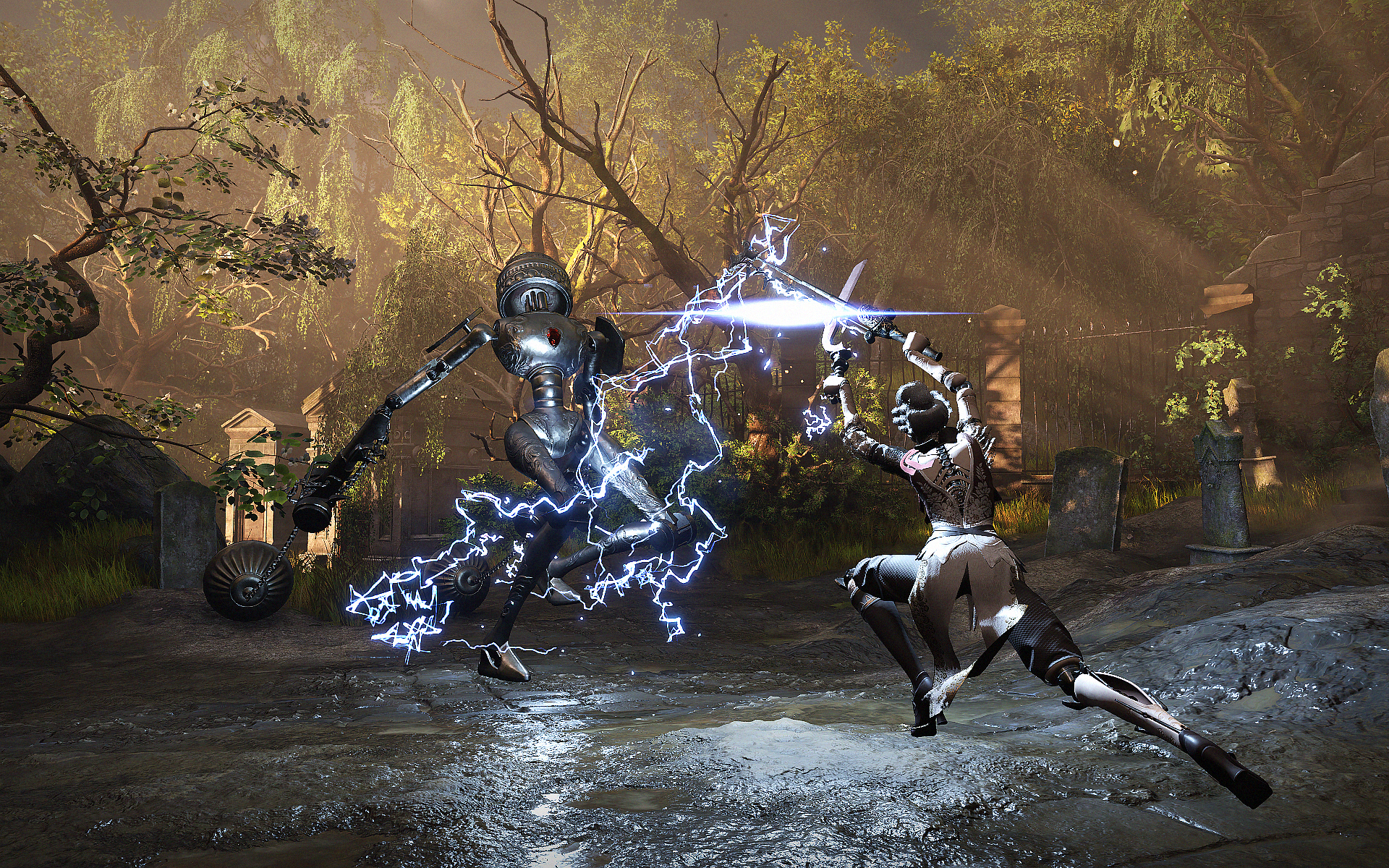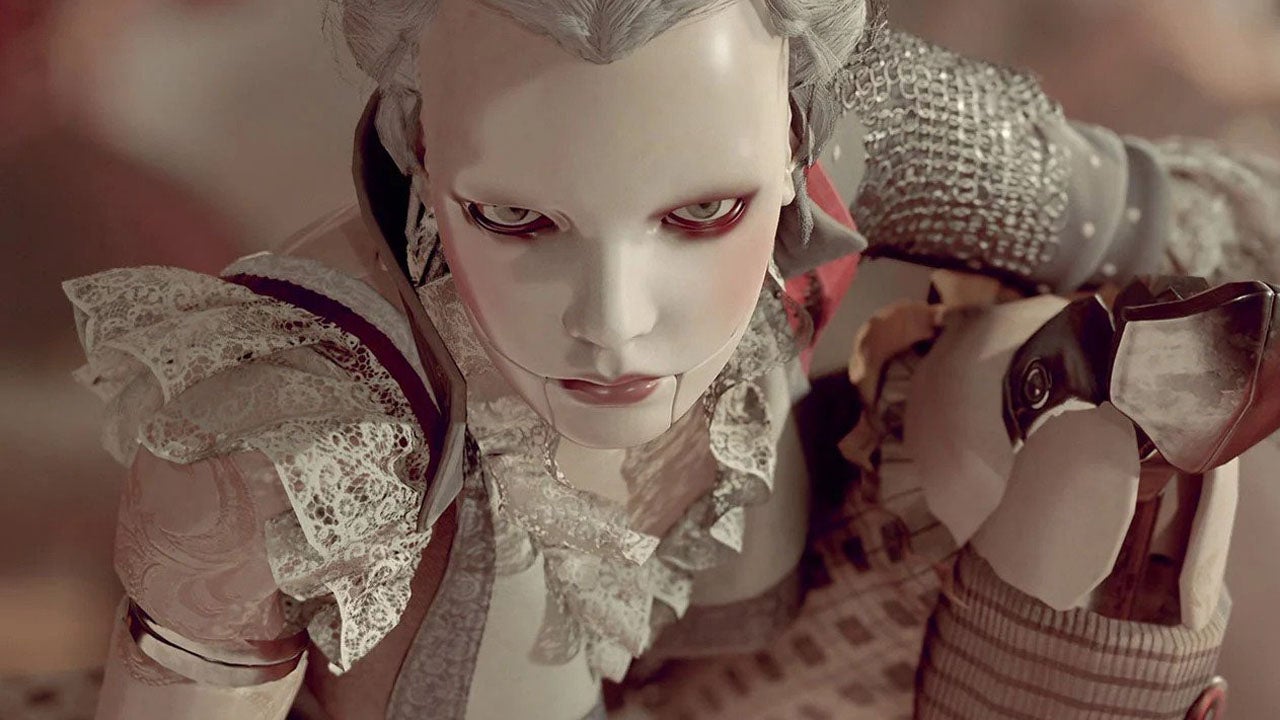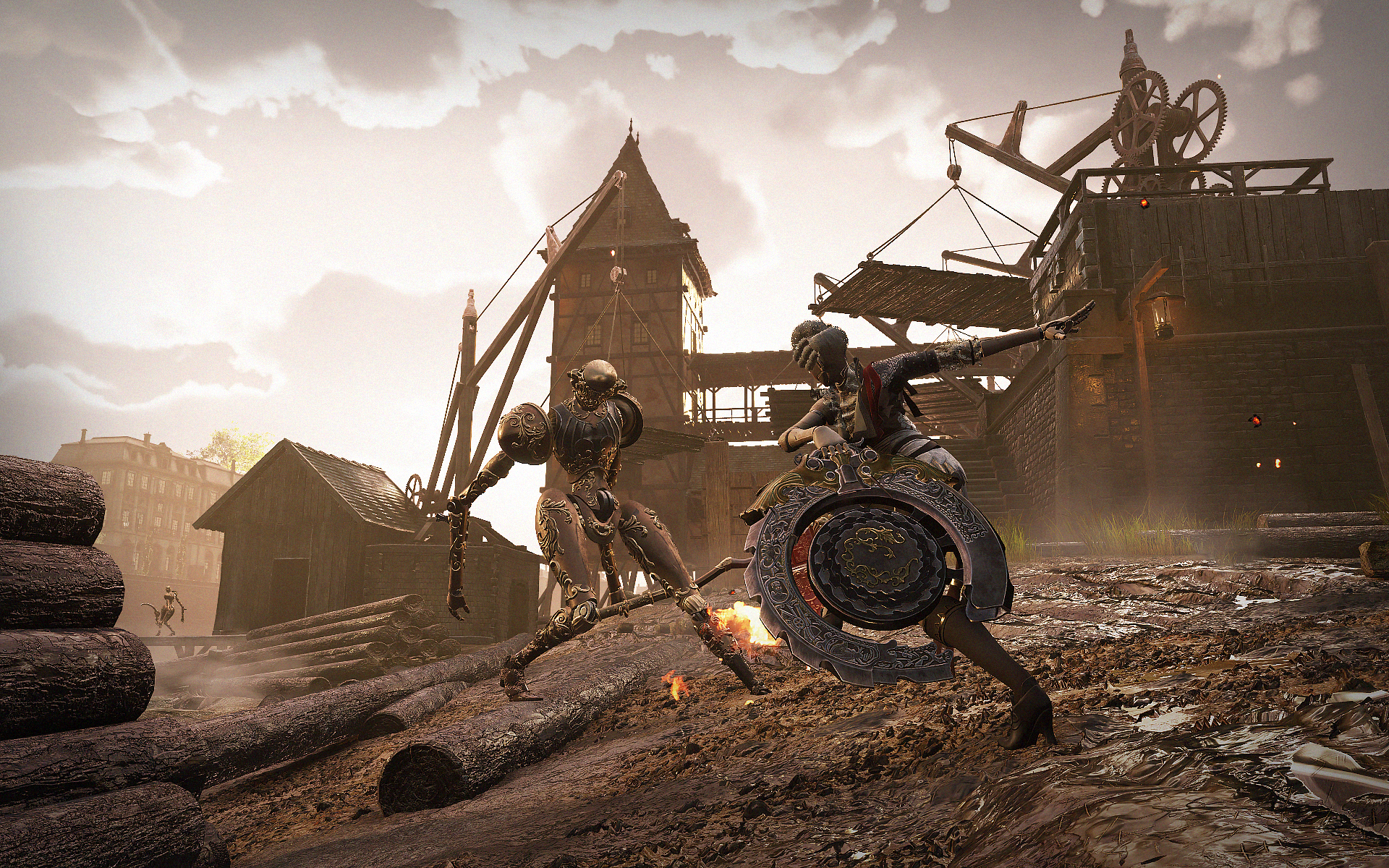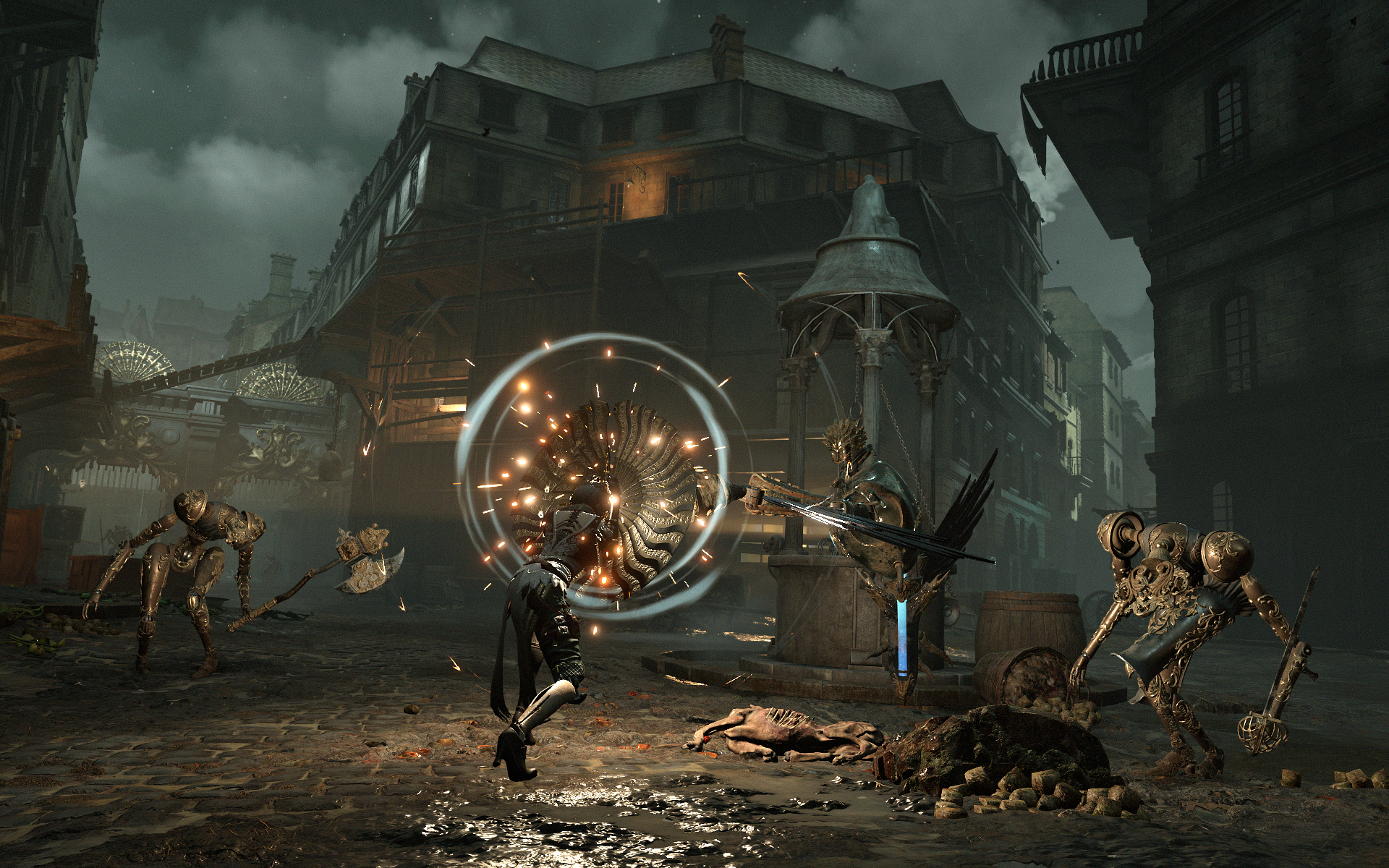Let’s start with what you likely already know. SteelRising is a third-person action game, where you adventure across several levels taking on an environment packed full of difficult enemies before encountering a gigantic boss posing a significant challenge. You have rechargeable healing items that are restored at set resting points, as well as a variety of consumables that aide in combat. Killing enemies provides currency which can, in turn, be used to upgrade your character and weaponry. It’s a Souls-like. Chances are if you’re reading this review, you know exactly what foundation Steel Rising is built upon. For what it’s worth, this foundation is fairly solid! Your movement as a French murder doll in the midst of combat has you weaving in-between attacks and string together powerful combos with a mix of regular, heavy, and special attacks. Put on enough pressure and you can break an enemy’s posture, allowing you to land a single devastating attack. Backstabs aren’t here, but are instead replaced with a universal sneak attack you can land on any and all unaware automata. If you’re fiending for some of that Dark Souls-esque action, feats like these do indeed cause your brain to shoot off those sweet signals. Now, there are blemishes here and there with that bread-and-butter action in SteelRising. What was clear to me through two separate playthroughs is that many weapons feel somewhat clunky to fight with. Stiff and nonliquid. Now, this may well have been intentional from the team at Spiders, seeing as the extraordinary addition to the setting of revolutionary France are the walking (in your case talking) animatronics making their way around Paris. But the occasional slow and clunky attack strings on non-uber massive armaments turned me off several options. I did, however, find solace in agility weapons, which are agile in your hands and sometimes make use of ballet moves which was a lush surprise amidst a widely unappealing selection. On the topic of weapons, I have to mention elemental reactions. Because they also hide a major problem I had with the game. Through the use of weapon skills, you can dish out fire, ice, or electrical damage which when stacked up enough results in an explosive effect. You can set enemies aflame, dealing continuous burns. You can electrify them, dealing additional damage, too! The issue comes with the ice, as it allows you to freeze enemies and bosses alike. Yup, that’s right: unless the big bad boss fight you’re up against is an ice-user themselves, you can freeze them in place for several seconds. This kind of took the wind out of my first playthrough’s sails. Special moves that apply elemental effects use a limited resource called Alchemical Capsules, a natural way of limiting how often you can use your most powerful moves. This isn’t great in my mind — it punishes me for using some of the coolest aspects of my build and encourages a most conservative approach when first traversing your way through an area. What if you need to cash in your most powerful attacks later? As such, it’s easy to find yourself saving until you reach the boss, at which point you have a staggering surplus of capsules, allowing you to chain stun the majority of bosses in Steel Rising to death with ice weaponry. If you do pick this game up, we would recommend staying away from frozen weapons — they really pluck the fangs from an otherwise tricky title. What about the setting? I’ll write it plainly — I loved looking around revolutionary Paris, its villages and palaces, docks and alleyways. It’s genuinely an enrapturing environment to navigate around, and while you’re obviously not getting the diversity in scenery you’d see with high- or dark-fantasy titles, I never once felt as though I was in an overly fictionalised version of Paris. It was as though you could wipe the robots away and a historic war-torn France would be left. It’s the perfect stage to inject some truly absurd, extravagant, and – yes, horrific – enemies throughout. That’s why it damn near broke my heart that SteelRising doesn’t push hard enough — doesn’t go wild enough. The vast majority of enemies you’ll fight are two-legged robotic soldiers, with a sword or gun or flaming axe attached. It’s largely humanoid and boorish, with even the more elite foes taking a largely plain form. I would trade the spinning assault acolytes and towering spear-and-shield guards found in the later levels for something as exciting as the fire or ice spewing Stalker Serpents, or something that goes as wild as some of the bosses do. The story of Steel Rising is an interesting goo, oozing between the different zones and conjoining a devastated Paris and a steampunk fantasy disaster. Narrative flows through SteelRising in three forms: the mystery behind the robots that have crushed the city, the rising political power against King Louis XVI and his Croney who are responsible for the devastation and discovering the deal with your own character. While I obviously won’t spoil these threads, I’ll say each vary in their elegance and ability to captivate. The secret behind your character and stopping the big bad was the most vanilla of the gang, with the big twist signaled with the subtlety of an airport marshal signaling a plane to land. The French uprising itself portrayed between a gaggle of named aristocrats, generals, scientists and more that kept me less enthralled than the starving, desperate, dooming citizens locked inside their houses. I did dig the secret behind the murderous machine-len men, but upon reflection it had me frustrated yet again that rank-and-file enemies weren’t more elaborate — the groundwork is there to justify it. A special shout out goes to the approach to your character’s voice. Early in the game you — as a robot — speak robotically. Made sense to me! Although it did have the unfortunate effect of making me not care too much about them, making me feel as though I was piloting an art-store mannequin with a gun and chain. However, they slowly become more emotive, which erupts in a scene later in the game that succeeded in snatching back my interest. There are some delightful caveats to the largely underwhelming overall experience in SteelRising. Your stamina bar has a quick refresh thanks to the character’s cooling system, allowing you to stay on the offensive at the cost of a hefty dose of icy chills that can freeze you solid if used haphazardly. This is a nice spin on the traditional combat formula that encourages aggressiveness. I like the compass, too: an active tool that points you in the direction of main and side quests, but crucially not towards items in the area, allowing me to venture across buildings without the fear of getting lost. There’s also an assisted mode for the game, which I’m sure will be greatly appreciated by those who come to these sorts of games for the vibes and enrapturing stories rather than getting DDT’d by Fume Knight over and over again. Thinking about everything in SteelRising together, as a whole package, it’s clear that Spiders’ action-RPG debut is not some out-of-nowhere mind-blowing experience. It’s not a trend-setter, nor does it push the boundaries of the Souls-like subgenre too much. It is, however, fun in bursts of play. There is quality in here: some great ideas and moments that have the capacity to wrench audible reactions from you, between a lot of middling filler. I do hope that the team at Spiders revisit the genre later down the line, take what is good from SteelRising, and give it another go. The game tickles that part of your brain that big hitters like Elden Ring and Dark Souls do, even if it does so with less intensity. If you’re absolutely fiending for more of that kind of game, or are just looking for a fair-weather bash, pick it up with tempered expectations.





